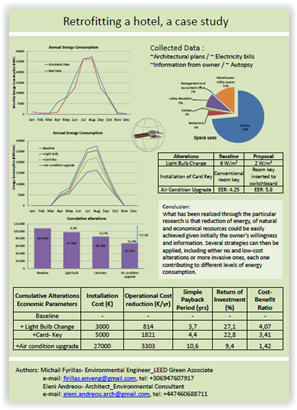Retrofitting an existing hotel, a case study

The building industry is responsible for ~40% of energy consumption worldwide and for ~30% of the greenhouse gases emitted into the atmosphere (UNEP, 2009). Specifically, the accommodation industry is estimated to be responsible for around 97.5TWh as measured for 2001, with the average energy use moving within the range of 305-330 KWh/m²yr (Hotel Energy Solutions, 2010). Thus, a strategic initiative for the reduction of the energy consumption -even with the minimum inpidual effort- seems to be an imperative need and is believed to contribute to a considerable decrease of the associated emissions globally.
The case study hotel is a 3-stars facility with 74 bedrooms, with a gross building area of 2500m², in a site of 4200 m². It is located in Zakynthos, an island of western Greece, and has been built under the standard building regulations. The architectural plans and the energy bills of a 9-month period have been provided.
A basic strategy has been suggested which has been based on two axes. The first axis was the collection of the provided actual energy bills and the estimation of the annual energy consumption. The second axis was an energy simulation of the building using as data some figures that could create a baseline for the energy consumption. Using the specific baseline, a number of potential modifications have been recommended to achieve a significant energy reduction. The simulation software that has been used is eQuest. The deviation of the actual annual energy consumption and the simulated data has been approximately 11%. This deviation may seem considerable but it has to be highlighted that the data provided was only for 9-month period. If the data gathered was for 1 or 2 years, then the results would be more precise. But even in this case, the two curves (actual and simulation figures) are remarkably close in the monthly basis.
Starting with some less intrusive and continuing with other more invasive alterations, the reduction of the energy consumption of the case study hotel is targeted. The suggestions were related to the change of the thermostat by 1.1°C (2°F), the replacement of the traditional light bulbs with LEDs, the installation of a card key in all rooms, the improvement of the air-conditioning system and lastly, with the application of additional external wall insulation. The energy consumption achieved thanks to each one of the suggested measures is depicted in Table 1.
The basic aim of the particular project was not to prove the efficiency of the recommended modifications but to highlight that each project is unique and that, given the owner’s willingness and the design and consultancy team’s critical research and study, crucial economic and environmental improvements can be achieved with the minimum effort. Moreover, it has to be emphasized that with the proper design of a long-term plan, the funding of the each measure could easily be succeeded thanks to reduction of the operational costs achieved from the previous measure applied.









